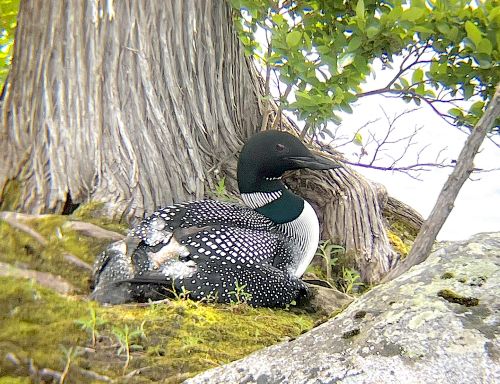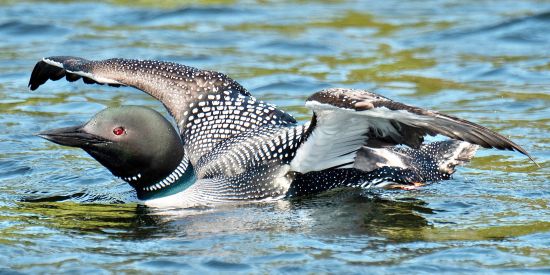
Why So Loony?

Loon season is upon us, and as you hear the seemingly abundant wolf-like calls of the waterfowl, you’d never suspect that the species is facing steadily decreasing population productivity every year. My name is Jodie Tsih, and I am one of the Colby interns working with Loon Conservation Associates and Belgrade Lakes Association this summer. Alongside my colleague Barlow Herbst, we’ve been surveying Great Pond and Long Pond for the past month to see what the loons are up to.
One may ask, why dedicate an entire summer to loons? Other than their popular appearance on the license plate of Maine vehicles, what’s so special about loons? To be frank, I had little to no knowledge of loons before this summer. Besides the obvious perks of getting to be outside on the lake all summer long, monitoring loon populations didn’t seem to be the most enticing ordeal, especially considering my lack of lust for avians overall. However, my passion for wildlife conservation trumps all, and I decided to take the plunge.

I am so grateful for this opportunity, which is only possible through the Buck Lab at Colby, because I have now become loony for loons! (Sorry for the corny pun!) The way the water glistens in the sun on their feathers, the enchanting ruby-red eyes, the grace with which they dive and swim underwater — it is truly a gift to watch these birds every morning. Don’t get me wrong, waking up at 5 a.m. every day is no easy feat for me, but the thrill of spotting a nesting loon wakes me up every morning.
Going into this internship, I expected it to be monotonous and somewhat boring, but boy, have I been proven wrong! Loons can be fickle creatures, and they won’t play fair with you. If they don’t want to be seen, you will never see them again. There have been countless times where we’ve spotted a loon, and as we get closer to it in hopes of identifying the bird, it disappears underwater, leaving only fleeting air bubbles. These loons can give you a run for your money. I thought, “How hard can it be to watch loons on the lake?,” and let me tell you, I can no longer count how many times I’ve mistaken a birch log or bark for the sneaky loon.

Although it does not seem like these beautiful birds are struggling, our surveys have indicated otherwise. Loons lay only two eggs each year, and most of the time, only one will successfully hatch. Even when both eggs hatch, we’ve seen that only one chick ends up surviving after the first or second week. On Long Pond, there is only one surviving chick and no active nests. With less than a week left in breeding season, it is concerning that the loons don’t seem too keen on blessing us with their offspring.
While the enchanting (and sometimes frustrating!) presence of loons gracing the lakes of Belgrade may seem plentiful and resilient, their declining population productivity tells a different story. My experience this summer with Loon Conservation Associates and the Belgrade Lakes Association has been nothing short of eye-opening. The delicate balance of their existence and the challenges they face in reproducing and nurturing their young underscore the importance of continued conservation efforts. What began as a mere internship has transformed into a profound appreciation for these captivating birds and the vital work needed to ensure their survival.

Despite the early mornings and the elusive nature of loons, the privilege of observing and contributing to their conservation has been incredibly rewarding. This journey has not only deepened my passion for wildlife conservation but also instilled in me a sense of responsibility to advocate for these remarkable creatures. As the breeding season draws to a close, the sight of each surviving chick is a reminder of the fragility of life and the critical role we play in safeguarding our natural world.
Thank you Jodie! If you have a particular questions regarding our Belgrade loon population, please email your inquiry to info@blamaine.org and we will try to answer your question, either in this column or via email. Have a great summer enjoying the “Call of the Loon” here at “home” in the Belgrade Lakes!
—Dick Greenan
Dick Greenan is chairman of the Belgrade Lakes Association’s Loon Preservation Project.
Download Full Newspaper: High Res | Low Res (Details…)
<— Previous Article • Summaries • Next Article —>
©2024 by Summertime in the Belgrades. All rights reserved.